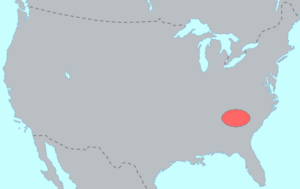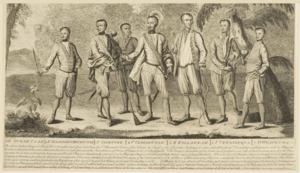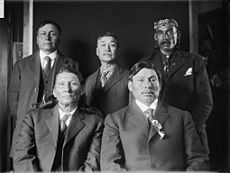Cherokee history facts for kids
The Cherokee people have a rich history, filled with traditions, stories, and written records. Today, the main groups of Cherokee are the Eastern Band of Cherokee Indians in North Carolina, and the Cherokee Nation and United Keetoowah Band of Cherokee Indians in Oklahoma. Their history is kept alive through the Cherokee language (using the Cherokee syllabary) and the English language.
Contents
Where Did the Cherokee Come From?
The Cherokee are part of the Iroquoian language family of North American indigenous peoples. It's believed they moved a long time ago from the Great Lakes area, where most Iroquoian-speaking groups lived. Their oral stories tell about this journey. They settled in the Southeastern Woodlands. This area includes parts of what is now western Virginia, southeastern Tennessee, western North and South Carolina, and northeastern Georgia. Later, in the late 1700s, some Cherokee moved further south and west into Georgia and Alabama.

The Mississippian culture was a big civilization that influenced many people across the Ohio and Mississippi valleys and into the Southeast. They built large towns with big mounds and earthworks. These mounds were used for religious events, political meetings, and sometimes as homes or burial sites for important people. In the Cherokee homeland in western North Carolina, archaeologists have found these ancient mounds. They were built by people who were ancestors of the Cherokee.
As the Cherokee developed, they started building large townhouses on top of these mounds. Over centuries, they would add to or rebuild these townhouses, making the mounds bigger in the process. Corn was, and still is, very important to Cherokee religious ceremonies, especially the Green Corn Ceremony. This tradition was shared with other Iroquoian tribes and other Southeastern groups like the Creek, Choctaw, Yuchi, and Seminole.
First European Contact
In 1540, a Spanish expedition led by Hernando de Soto traveled through Cherokee lands. They called the Cherokee a "Chalaque" nation. The Europeans brought new diseases like smallpox. The Cherokee and other tribes had no protection against these illnesses, and many people died.
Another Spanish expedition came in 1567, led by Juan Pardo. He was looking for a land route to silver mines. Spanish soldiers built forts in the Southeast, but the Native Americans fought back. The Spanish eventually left the area.
Early Cherokee Life
Much of what we know about early Cherokee life comes from the writings of American writer John Howard Payne. He recorded stories from Cherokee elders. They described a traditional society with two main groups. A "white" group of elders, who were like priests, handled religious activities such as healing and prayer. A "red" group of younger men was in charge of warfare. After battles, the priestly class would perform ceremonies to purify the warriors. This old system changed a lot before the 1700s. Some believe it changed after a revolt against the priestly class, known as the Ani-kutani.
Later, in the 1880s, ethnographer James Mooney studied the Cherokee. He noted that by then, religious practices were more informal. They were based on a person's knowledge and skill, not on who their family was. Another important source of history comes from writings by didanvwisgi (Cherokee medicine men). They used the Cherokee syllabary, a writing system created by Sequoyah in the 1820s. This writing system was very powerful and later became widely used by the Cherokee people.
Scholars believe the Cherokee migrated south from the Great Lakes region because they speak an Iroquoian language. However, some think the Iroquois moved north from the Southeast. Studies of languages suggest the Cherokee separated from other Iroquoian groups a very long time ago, perhaps between 1,500 and 1,800 B.C. The Cherokee consider their ancient town of Kituwa on the Tuckasegee River to be their original home in the Southeast.
Contact with the English
Regular contact with English colonists began in the mid-1600s. By 1650, about 22,500 Cherokee lived in independent towns and villages. Their territory covered about 40,000 square miles. The English were mainly looking for deerskins for Europe's leather industry. In return, they traded tools made of iron and steel, firearms, gunpowder, and ammunition.
Europeans divided Cherokee towns into groups based on their location:
- Lower Towns: Along the Keowee River in present-day western South Carolina and northeastern Georgia.
- Middle Towns: In present-day [[Western North Carolina]], along the Tennessee River's headwaters.
- Overhill Towns: Across the mountains in present-day eastern Tennessee and northwestern Georgia. Important towns included Chota, Tellico, and Tanasi.
- Out Towns: Along the Tuckasegee River and Oconaluftee River in Western North Carolina. Kituwa was the "mother town."
- Valley Towns: Along the Nantahala River and Valley Rivers in Western North Carolina.
By the late 1600s, traders from Virginia and South Carolina regularly visited Cherokee lands. In the 1690s, the Cherokee formed a strong trade relationship with the colony of South Carolina. This alliance with the English became very important for much of the 1700s.
18th Century History
From 1710 to 1715, the Cherokee and Chickasaw, allied with the English, fought the Shawnee. The Shawnee were allied with the French. The Cherokee also helped the English fight the Tuscarora in the Second Tuscarora War. After their defeat, most Tuscarora moved north to New York and joined the League of the Iroquois.
In 1716, Cherokee warriors attacked Muscogee Creek leaders. This led to decades of fighting between the Cherokee and Creek. The Cherokee won a major battle, the Battle of Taliwa, in 1755.
In 1730, at Nikwasi, a British official named Sir Alexander Cumming convinced the Cherokee to crown Moytoy of Tellico as "Emperor." Moytoy agreed to recognize King George II of Great Britain as the Cherokee's protector. Seven important Cherokee, including Attakullakulla, traveled to London, England, and signed a treaty with the British. However, political power among the Cherokee remained spread out, with each town making its own decisions.
In 1738 and 1739, smallpox epidemics hit the Cherokee. They had no natural protection against this disease, which was common among Europeans. Nearly half the Cherokee population died within a year.
From 1753 to 1755, the Cherokee and Muscogee fought over hunting grounds in North Georgia. During the French and Indian War, British soldiers built forts in Cherokee country to fight the French. These included Fort Loudoun near Chota. In 1756, the Cherokee fought with the British. However, misunderstandings led to the Anglo-Cherokee War in 1760.
After the Seven Years' War, Britain gained control of French lands east of the Mississippi River. King George III issued the Royal Proclamation of 1763. This rule tried to stop British settlers from moving west of the Appalachian Mountains, to protect the Cherokee and other tribes. But it was hard to enforce.
In 1776, during the American Revolutionary War, the Cherokee allied with the Shawnee. They attacked settlers in several states. Nancy Ward, an important Cherokee woman, warned settlers about these attacks. European-American militias fought back, destroying over 50 Cherokee towns. Most Cherokee leaders signed peace treaties with the new American states in 1777.
However, Dragging Canoe and his group moved to the area near present-day Chattanooga, Tennessee. They formed 11 new towns and became known as the Chickamauga. Dragging Canoe led a guerrilla war against settlers, known as the Cherokee–American wars. These wars ended with the Treaty of Tellico Blockhouse in 1794.
Around 1808, Sequoyah began creating his writing system, the Cherokee syllabary. He was one of the few people from a society without writing to create such an effective system. By 1821, he completed it, and it was quickly adopted by the Cherokee people.
19th Century Challenges
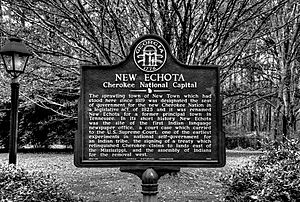
The Cherokee organized a national government with Principal Chiefs like Little Turkey and Pathkiller. The main town was Ustanali, near Calhoun, Georgia. Leaders like James Vann and Major Ridge became very influential. They had more contact with European Americans and favored adopting some of their ways, like formal education and farming methods.
The Removal Era
Some Cherokee, known as the "Lower Cherokee," were the first to move west. Leaders like Young Dragging Canoe and Sequoyah believed that moving voluntarily was the best way to save the Cherokee people. They felt that the growing number of American settlers, backed by the U.S. military, were too powerful to resist.
In 1815, the U.S. government set up a Cherokee Reservation in Arkansas. Groups led by The Bowl, Sequoyah, and others settled there. These Cherokee became known as "Old Settlers" or Western Cherokee.
John Ross became the Principal Chief in 1828 and served until 1866. He led the fight to resist the forced removal of the Cherokee from their lands in the Southeast.
The Trail of Tears
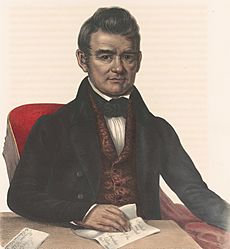
The Cherokee were being pushed off their ancestral lands in Georgia and the Carolinas. This was partly due to a gold rush in the 1830s. President Andrew Jackson claimed that removing the Cherokee would prevent them from disappearing. However, the Cherokee were actually adapting modern farming techniques and were economically successful. Jackson was under great pressure from white settlers who wanted the Cherokee lands.
In 1830, Chief Ross and other Cherokee leaders took their concerns to the U.S. Supreme Court. In the case Cherokee Nation v. Georgia, and later Worcester v. Georgia, the Supreme Court ruled that the Cherokee were protected by federal law from state governments. However, the state of Georgia largely ignored this ruling, and pressure for removal continued.
Most Cherokees were forcibly moved westward to Indian Territory in 1838–1839. This difficult journey is known as the Trail of Tears, or Nvna Daula Tsvyi (The Trail Where They Cried) in Cherokee. This happened under the Indian Removal Act of 1830. Some Cherokees who owned enslaved African Americans took them along on the journey. European Americans and missionaries who had married into the tribe also walked the Trail of Tears.
On June 22, 1839, in Indian Territory, Major Ridge, John Ridge, and Elias Boudinot were killed by supporters of John Ross. These men had signed the Treaty of New Echota, which gave away communal Cherokee lands. This was considered a serious crime. Stand Watie was also attacked but survived.
The Eastern Band
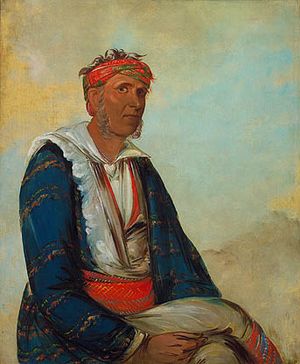
Some Cherokee in western North Carolina managed to avoid being removed. They became the Eastern Band of Cherokee Indians. William Holland Thomas, a white store owner, helped over 600 Cherokee from Qualla Town become citizens of North Carolina. By giving up their tribal citizenship, they were not forced to move. Over 400 other Cherokee hid in the remote Snowbird Mountains, led by Tsali (ᏣᎵ). Others negotiated directly with the state government to stay. Many of these were of mixed heritage or Cherokee women married to white men. These groups are the ancestors of most members of the Eastern Band of Cherokee Indians today.
Civil War and After
The American Civil War (1861-1865) was very hard for both Eastern and Western Cherokee. The Cherokee in North Carolina, helped by William Thomas, formed the Thomas Legion and fought for the Confederacy. In Indian Territory, the Cherokee split into Confederate and Union groups. Many leaders owned slaves, and the Confederacy promised to create an Indian state if they won. There was fighting within the tribe, and many Union supporters fled to Kansas.
After the Civil War, the United States required the Cherokee and other tribes who had sided with the Confederacy to sign new treaties. One important term was that they had to free their enslaved people and offer them tribal citizenship. Many Cherokee Freedmen became active in tribal politics.
The U.S. government also gained rights to build railroads through the western part of Cherokee territory, which became the Oklahoma Territory. This brought more development and settlers. By the late 1800s, the government believed that Native Americans would be better off if each family owned its own land. The Dawes Act of 1887 broke up communal tribal lands and gave individual plots to tribal members. This also allowed for the sale of land to people outside the tribe later on.
The Curtis Act of 1898 further weakened Native American governments. For the Oklahoma Territory, this meant the U.S. Federal Government ended the Cherokee courts and government systems. This was seen as necessary before Oklahoma and Indian territories could become a state.
By the late 1800s, the Eastern Band of Cherokees faced a segregated society in the South. Laws known as Jim Crow laws divided society into "white" and "colored." Native Americans were included on the "colored" side. They faced the same racial segregation and loss of voting rights as African Americans. These rights were not fully regained until the Civil Rights Movement in the mid-1960s.
Notable Cherokees in History
- Attakullakulla (ca. 1708-ca. 1777), a diplomat to Britain and chief.
- Bob Benge (ca. 1762–1794), a warrior during the Cherokee–American wars.
- Elias Boudinot (1802–1839), a statesman and editor who started the first Cherokee newspaper, the Cherokee Phoenix.
- Ned Christie (1852–1892), a Cherokee Nation senator.
- Rear Admiral Joseph J. Clark (1893–1971), the highest-ranking Native American in the U.S. military.
- Doublehead (d. 1807), a war leader who signed land deals with the U.S.
- Dragging Canoe (1738–1792), a general during the 2nd Cherokee War and chief of the Chickamauga.
- Franklin Gritts, a Cherokee artist.
- Charles R. Hicks (d. 1827), a Principal Chief.
- Junaluska (ca. 1775–1868), a veteran of the Creek War who saved Andrew Jackson's life.
- Oconostota (ca. 1710–1783), a "Beloved Man" and war chief.
- Ostenaco (ca. 1703–1780), a war chief and diplomat to Britain.
- Major Ridge (ca.1771–1839), a veteran of the Cherokee–American wars and signer of the Treaty of New Echota.
- John Ridge (1792–1839), son of Major Ridge, a statesman and New Echota Treaty signer.
- Clement V. Rogers (1839–1911), a Cherokee senator, judge, and cattleman.
- Will Rogers, a famous Cherokee entertainer, roper, and author.
- John Ross (1790–1866), Principal Chief during the Removal and in the west.
- Sequoyah (ca. 1767–1843), the inventor of the Cherokee syllabary.
- Nimrod Jarrett Smith (1837–1893), Principal Chief of the Eastern Band.
- William Holland Thomas (1805–1893), a non-Native adopted into the tribe, and founding Principal Chief of the Eastern Band.
- James Vann (ca. 1765–1809), a successful Scottish-Cherokee businessman.
- Stand Watie (1806–1871), a signer of the Treaty of New Echota and the last Confederate general to surrender in the American Civil War.
- Moses Whitmire (ca. 1848–1884), a Trustee for the Cherokee Freedmen who fought for their rights.



